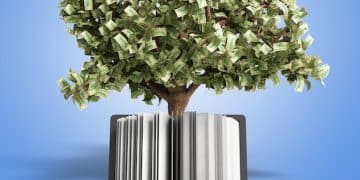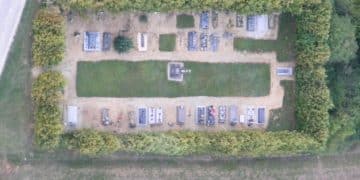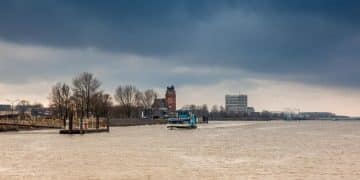Water Conservation: Simple Ways US Households Can Reduce Consumption by 25%
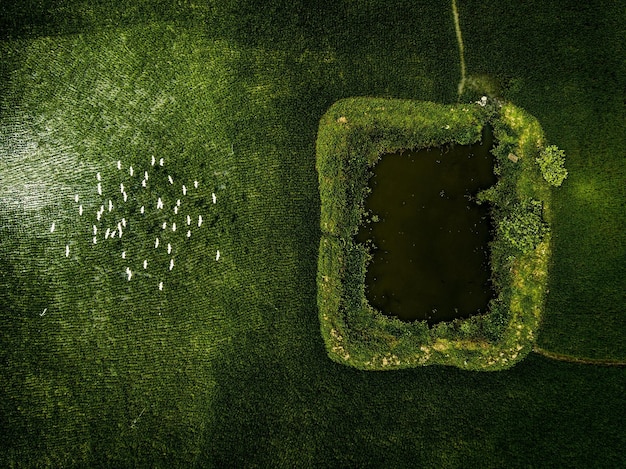
Understanding the Science of Water Conservation: How Can US Households Reduce Water Consumption by 25% Through Simple Changes? This article explores practical steps and scientific insights enabling American households to significantly cut water usage, benefiting both the environment and their wallets.
Understanding the Science of Water Conservation: How Can US Households Reduce Water Consumption by 25% Through Simple Changes? It’s not just an environmental imperative, but also a smart financial move. Let’s explore how small adjustments can make a big impact.
The Importance of Water Conservation in the US
Water scarcity is becoming an increasingly pressing issue across the United States. From droughts in the West to aging infrastructure in the East, many regions are facing significant challenges in maintaining a reliable water supply. Understanding the urgency of water conservation is the first step toward making meaningful changes.
Conserving water not only helps protect our environment but also offers tangible economic benefits for households. By adopting simple water-saving practices, families can significantly reduce their monthly water bills and contribute to a more sustainable future.
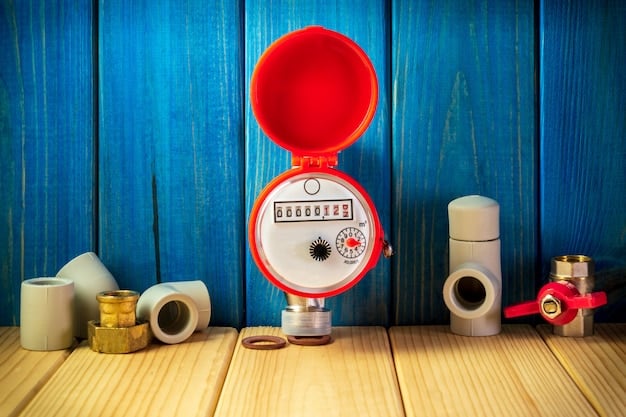
The Environmental Impact of Water Waste
Wasting water has far-reaching environmental consequences. Excessive water consumption can deplete aquifers, reduce river flows, and harm aquatic ecosystems. Moreover, the energy required to pump, treat, and distribute water contributes to greenhouse gas emissions.
By embracing water conservation, we can lessen our environmental footprint and help safeguard these essential resources for future generations.
- Reduced Energy Consumption: Less water usage means less energy needed for pumping and treatment.
- Preservation of Ecosystems: Maintaining healthy river flows and water levels protects aquatic life.
- Mitigation of Drought Effects: Conserving water helps communities better withstand periods of drought.
- Lower Greenhouse Gas Emissions: Decreased energy consumption reduces carbon footprint.
Ultimately, water conservation is an investment in the health and resilience of our planet. It is a responsibility we all share.
Understanding Your Household Water Footprint
Before implementing water-saving measures, it’s crucial to understand how your household currently uses water. Identifying the biggest water consumers in your home allows you to target your efforts effectively. A water audit can provide valuable insights into your water usage patterns.
Conducting a simple self-assessment or hiring a professional auditor can reveal surprising sources of water waste. This knowledge empowers you to make informed decisions and prioritize conservation efforts.
Common Culprits of Water Waste
Many households unknowingly waste significant amounts of water through everyday activities. Leaky faucets, inefficient toilets, and overwatering lawns are common culprits.
Addressing these issues can lead to substantial water savings without requiring drastic lifestyle changes.

Calculating Your Water Footprint
Several online calculators and resources can help you estimate your household’s water footprint. These tools consider factors such as the number of residents, landscape size, and watering habits.
By quantifying your water usage, you can set realistic goals and track your progress over time.
- Online Calculators: Tools that estimate water usage based on household characteristics.
- Water Bills: Analyzing past bills helps identify water usage trends.
- Water Audit: A professional assessment of water consumption and potential savings.
Understanding your water footprint provides a foundation for effective conservation strategies. It’s the first step toward reducing water consumption by 25%.
Low-Flow Fixtures and Appliances
Upgrading to low-flow fixtures and appliances is one of the most effective ways to reduce household water consumption. These devices use less water without sacrificing performance, making them a smart investment for any homeowner.
From toilets to showerheads, low-flow options are readily available and easy to install. The savings can be significant, particularly in households with multiple occupants.
Low-Flow Toilets
Traditional toilets can use up to six gallons of water per flush, while low-flow toilets use only 1.6 gallons or less. Replacing old toilets with WaterSense-certified models can save thousands of gallons of water each year.
These toilets are designed to provide powerful flushing performance while minimizing water waste.
Water-Efficient Showerheads
Low-flow showerheads restrict water flow without reducing water pressure. Many models use less than 2.5 gallons per minute (GPM), compared to traditional showerheads that can use up to five GPM.
Switching to a water-efficient showerhead can save a significant amount of water over time.
Energy Star Appliances
When purchasing new dishwashers and washing machines, look for Energy Star certified models. These appliances are designed to use less water and energy than standard models.
In addition to saving water, Energy Star appliances can also lower your electricity bills.
Investing in low-flow fixtures and appliances is a simple yet impactful way to conserve water. These upgrades can lead to long-term savings and reduced environmental impact.
Smart Landscaping and Outdoor Water Use
Outdoor water use accounts for a significant portion of household water consumption, particularly in arid and semi-arid regions. Switching to smart landscaping practices can dramatically reduce water waste.
Consider replacing water-intensive lawns with drought-tolerant plants, using efficient irrigation systems, and adopting water-wise gardening techniques.
Xeriscaping
Xeriscaping involves designing landscapes that require minimal irrigation. This approach utilizes native plants, gravel mulch, and efficient watering methods to conserve water.
Xeriscaping not only reduces water consumption but also creates beautiful and low-maintenance outdoor spaces.
Efficient Irrigation Systems
Traditional sprinkler systems can waste a lot of water due to evaporation and runoff. Drip irrigation systems deliver water directly to plant roots, minimizing waste and maximizing efficiency.
Smart irrigation controllers can also help by adjusting watering schedules based on weather conditions.
Water-Wise Gardening Techniques
Mulching around plants helps retain moisture in the soil, reducing the need for frequent watering. Collecting rainwater in barrels provides a free and sustainable source of water for irrigation.
Choosing drought-tolerant plants and grouping plants with similar water needs can further minimize water waste.
- Use Native Plants: Native plants are adapted to the local climate and require less water.
- Mulch Regularly: Mulch helps retain soil moisture and reduces evaporation.
- Collect Rainwater: Rain barrels can provide a sustainable source of water for irrigation.
- Water Deeply and Less Frequently: Encourages deep root growth and reduces surface evaporation.
By implementing smart landscaping practices, homeowners can significantly reduce their outdoor water consumption and create beautiful, sustainable landscapes.
Behavioral Changes and Water-Saving Habits
In addition to installing low-flow fixtures and adopting smart landscaping practices, making simple behavioral changes can also contribute to significant water savings. These changes require little to no investment and can easily be incorporated into your daily routine.
Being mindful of your water usage and adopting water-saving habits is key to reducing your household’s water consumption by 25%.
Water-Wise Bathroom Habits
Taking shorter showers, turning off the tap while brushing your teeth, and fixing leaky faucets are all simple ways to save water in the bathroom.
Encouraging family members to adopt these habits can lead to substantial water savings over time.
Efficient Kitchen Practices
Washing full loads of dishes in the dishwasher, using a bowl of water to wash fruits and vegetables, and avoiding running the tap while waiting for water to heat up are all effective water-saving practices in the kitchen.
These small changes can make a big difference in your overall water consumption.
Laundry Best Practices
Washing full loads of laundry, using the appropriate water level setting, and choosing cold water cycles can all help conserve water in the laundry room.
Consider using a high-efficiency washing machine that uses less water per load.
Adopting water-saving habits in your daily routine is a simple and effective way to conserve water. These changes require minimal effort but can lead to significant long-term savings.
Monitoring and Maintaining Your Water System
Regular monitoring and maintenance of your water system are crucial for identifying and addressing leaks and other sources of water waste. Proactive maintenance can prevent costly repairs and ensure that your water system is operating efficiently.
Conducting regular inspections and addressing potential issues promptly can help you reduce your household’s water consumption and save money on your water bill.
Checking for Leaks
Regularly inspect faucets, toilets, and pipes for leaks. Even small drips can waste a significant amount of water over time. A running toilet can waste hundreds of gallons of water each day.
Repair leaks promptly to prevent further water waste and potential damage to your home.
Maintaining Your Irrigation System
Inspect your irrigation system regularly for leaks, clogs, and broken sprinkler heads. Adjust sprinkler heads to ensure that water is directed to plants and not onto sidewalks or driveways.
Consider hiring a professional to perform a seasonal irrigation system tune-up.
Monitoring Your Water Meter
Periodically check your water meter for unusual activity. If you notice a sudden spike in water consumption, it could indicate a hidden leak. To check for leaks, turn off all water-using appliances and fixtures and observe the water meter. If it continues to move, you likely have a leak.
Monitoring your water meter can help you detect and address leaks early on, preventing significant water waste.
- Regular Inspections: Check faucets, toilets, and pipes for leaks regularly.
- Irrigation System Maintenance: Inspect and adjust sprinkler heads to ensure efficient watering.
- Water Meter Monitoring: Check for unusual activity that could indicate a hidden leak.
By monitoring and maintaining your water system, you can identify and address leaks and other sources of water waste, helping you conserve water and save money.
Community Engagement and Water Conservation Programs
Participating in community engagement and water conservation programs can provide additional resources and support for your water-saving efforts. Many municipalities and water utilities offer rebates, incentives, and educational programs to encourage water conservation.
Engaging with your community and taking advantage of available resources can help you achieve even greater water savings and contribute to a more sustainable future.
Local Water Conservation Programs
Check with your local water utility for information on available water conservation programs. These programs may offer rebates for installing low-flow fixtures, incentives for switching to drought-tolerant landscaping, and free water audits.
Participating in these programs can help you save money and reduce your water consumption.
Community Workshops and Events
Attend community workshops and events to learn more about water conservation best practices. These events often feature expert speakers, demonstrations, and hands-on activities.
Connecting with other community members who are passionate about water conservation can provide valuable support and inspiration.
Advocating for Water Conservation Policies
Support local and state policies that promote water conservation. Advocate for responsible water management practices and investments in water-efficient infrastructure.
By working together, we can create a more sustainable water future for our communities.
Community engagement and water conservation programs can provide valuable resources and support for your water-saving efforts. By participating in these initiatives, you can learn new strategies, save money, and contribute to a more sustainable future.
| Key Point | Brief Description |
|---|---|
| 💧 Low-Flow Fixtures | Install low-flow toilets, showerheads, and faucets to reduce water usage. |
| 🌿 Smart Landscaping | Use xeriscaping and efficient irrigation to minimize outdoor water use. |
| 🚿 Water-Saving Habits | Take shorter showers, fix leaks, and wash full loads of laundry. |
| 🔍 Monitor Water Use | Regularly check your water meter and system for leaks. |
FAQ
▼
Water conservation is crucial due to increasing water scarcity, droughts, and aging infrastructure. Conserving water protects ecosystems, reduces energy consumption, and ensures a sustainable water supply for future generations.
▼
You can estimate your water footprint using online calculators or by analyzing your water bills to identify usage trends. A professional water audit can also provide a detailed assessment.
▼
Low-flow fixtures, like toilets and showerheads, use less water without sacrificing performance. They reduce water consumption, lower water bills, and contribute to environmental sustainability.
▼
Xeriscaping designs landscapes requiring minimal irrigation by using native plants and efficient watering methods. It reduces water consumption and creates low-maintenance outdoor spaces.
▼
Regularly inspect faucets, toilets, and pipes for leaks. Monitor your water meter for unusual activity. Turn off all water-using appliances and fixtures and observe the meter for movement to detect leaks.
Conclusion
Understanding the Science of Water Conservation: How Can US Households Reduce Water Consumption by 25% Through Simple Changes? By implementing a combination of water-efficient technologies, adopting water-saving habits, and engaging with your community, you can significantly reduce your household’s water consumption and contribute to a more sustainable future for all. The power to conserve water lies in the hands of each individual, and every drop saved makes a difference.
